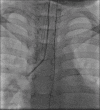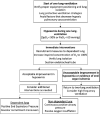Anesthesia for thoracic surgery in infants and children
- PMID: 34764836
- PMCID: PMC8579498
- DOI: 10.4103/sja.SJA_350_20
Anesthesia for thoracic surgery in infants and children
Abstract
The management of infants and children presenting for thoracic surgery poses a variety of challenges for anesthesiologists. A thorough understanding of the implications of developmental changes in cardiopulmonary anatomy and physiology, associated comorbid conditions, and the proposed surgical intervention is essential in order to provide safe and effective clinical care. This narrative review discusses the perioperative anesthetic management of pediatric patients undergoing noncardiac thoracic surgery, beginning with the preoperative assessment. The considerations for the implementation and management of one-lung ventilation (OLV) will be reviewed, and as will the anesthetic implications of different surgical procedures including bronchoscopy, mediastinoscopy, thoracotomy, and thoracoscopy. We will also discuss pediatric-specific disease processes presenting in neonates, infants, and children, with an emphasis on those with unique impact on anesthetic management.
Keywords: One-lung ventilation; pediatric anesthesia; thoracic surgery; thoracoscopy; thoracotomy.
Copyright: © 2021 Saudi Journal of Anesthesia.
Conflict of interest statement
There are no conflicts of interest.
Figures










References
-
- Meneghini L, Zadra N, Zanette G, Baiocchi M, Giusti F. The usefulness of routine preoperative laboratory tests for one-day surgery in healthy children. Pediatr Anesth. 1998;8:11–5. - PubMed
-
- Nieto RM, De León LE, Diaz DT, Krauklis KA, Fraser CD., Jr Routine preoperative laboratory testing in elective pediatric cardiothoracic surgery is largely unnecessary. J Thorac Cardiovasc Surg. 2017;153:678–85. - PubMed
-
- Lee EY, Tracy DA, Mahmood SA, Weldon CB, Zurakowski D, Boiselle PM. Preoperative MDCT evaluation of congenital lung anomalies in children: Comparison of axial, multiplanar, and 3D images. AJR Am J Roentgenol. 2011;196:1040–6. - PubMed
-
- Baum VC, Barton DM, Gutgesell HP. Influence of congenital heart disease on mortality after noncardiac surgery in hospitalized children. Pediatrics. 2000;105:332–5. - PubMed
Publication types
LinkOut - more resources
Full Text Sources
